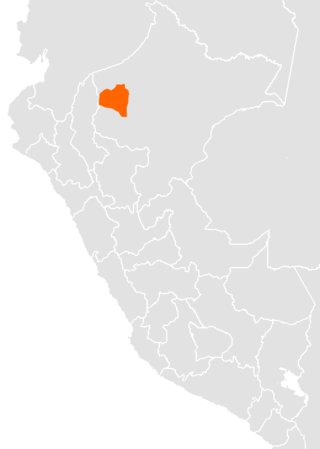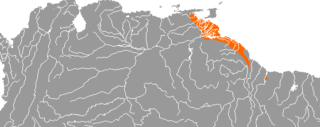Linguistic typology is a field of linguistics that studies and classifies languages according to their structural features to allow their comparison. Its aim is to describe and explain the structural diversity and the common properties of the world's languages. Its subdisciplines include, but are not limited to phonological typology, which deals with sound features; syntactic typology, which deals with word order and form; lexical typology, which deals with language vocabulary; and theoretical typology, which aims to explain the universal tendencies.

The Cariban languages are a family of languages indigenous to northeastern South America. They are widespread across northernmost South America, from the mouth of the Amazon River to the Colombian Andes, and they are also spoken in small pockets of central Brazil. The languages of the Cariban family are relatively closely related. There are about three dozen, but most are spoken only by a few hundred people. Macushi is the only language among them with numerous speakers, estimated at 30,000. The Cariban family is well known among linguists partly because one language in the family—Hixkaryana—has a default word order of object–verb–subject. Prior to their discovery of this, linguists believed that this order did not exist in any spoken natural language.

Munichi is a recently extinct language which was spoken in the village of Munichis, about 10 miles (16 km) west of Yurimaguas, Loreto Region, Peru. In 1988, there were two mother-tongue speakers, but they had not met since the 1970s. The last known fluent speaker, Victoria Huancho Icahuate, died in the late 1990s. As of 2009 there were several semi-speakers who retained significant lexical, and partial grammatical, knowledge of the language.
The Waorani (Huaorani) language, commonly known as Sabela is a vulnerable language isolate spoken by the Huaorani people, an indigenous group living in the Amazon rainforest between the Napo and Curaray Rivers in Ecuador. A small number of speakers with so-called uncontacted groups may live in Peru.

The Nadahup languages, also known as Makú (Macú) or Vaupés–Japurá, form a small language family in Brazil, Colombia, and Venezuela. The name Makú is pejorative, being derived from an Arawakan word meaning "without speech". Nadahup is an acronym of the constituent languages.

The Chicham languages, also known as Jivaroan is a small language family of northern Peru and eastern Ecuador.

Puquina is a small, putative language family, often portrayed as a language isolate, which consists of the extinct Puquina language and Kallawaya, although it is assumed that the latter is just a remnant of the former mixed with Quechuan. Puquina speakers are last mentioned in the early nineteenth century.
Yuracaré is an endangered language isolate of central Bolivia in Cochabamba and Beni departments spoken by the Yuracaré people.
In linguistic typology, object–verb–subject (OVS) or object–verb–agent (OVA) is a rare permutation of word order. OVS denotes the sequence object–verb–subject in unmarked expressions: Oranges ate Sam, Thorns have roses. The passive voice in English may appear to be in the OVS order, but that is not an accurate description. In an active voice sentence like Sam ate the oranges, the grammatical subject, Sam, is the agent and is acting on the patient, the oranges, which are the object of the verb, ate. In the passive voice, The oranges were eaten by Sam, the order is reversed and so that patient is followed by the verb and then the agent. However, the oranges become the subject of the verb, were eaten, which is modified by the prepositional phrase, by Sam, which expresses the agent, and so the usual subject–verb–(object) order is maintained.
Itonama is a moribund or extinct language isolate once spoken by the Itonama people in the Amazonian lowlands of north-eastern Bolivia. It was spoken on the Itonomas River and Lake in Beni Department.

The Urarina are an indigenous people of the Peruvian Amazon Basin (Loreto) who inhabit the valleys of the Chambira, Urituyacu, and Corrientes Rivers. According to both archaeological and historical sources, they have resided in the Chambira Basin of contemporary northeastern Peru for centuries. The Urarina refer to themselves as Kachá, while ethnologists know them by the ethnonym Urarina.

Candoshi-Shapra is an indigenous American language isolate, spoken by several thousand people in western South America along the Chapuli, Huitoyacu, Pastaza, and Morona river valleys. There are two dialects, Chapara and Kandoashi (Kandozi). It is an official language of Peru, like other native languages in the areas in which they are spoken and are the predominant language in use. Around 88.5 percent of the speakers are bilingual with Spanish. The literacy rate in Candoshi-Shapra is 10 to 30 percent and 15 to 25 percent in the second language Spanish. There is a Candoshi-Shapra dictionary, and grammar rules have been codified.
Kwaza is an endangered Amazonian language spoken by the Kwaza people of Brazil. Kwaza is an unclassified language. It has grammatical similarities with neighboring Aikanã and Kanoê, but it's not yet clear if that is due to a genealogical relationship or to contact.
Omurano is an unclassified language from Peru. It is also known as Humurana, Roamaina, Numurana, Umurano, and Mayna. The language was presumed to have become extinct by 1958, but in 2011 a rememberer was found who knew some 20 words in Omurano; he claimed that there were still people who could speak it.
Aikanã is an endangered language isolate spoken by about 200 Aikanã people in Rondônia, Brazil. It is morphologically complex and has SOV word order. Aikanã uses the Latin script. The people live with speakers of Koaia (Kwaza).

Harakmbut or Harakmbet is the native language of the Harakmbut people of Peru. It is spoken along the Madre de Dios and Colorado Rivers, in the pre-contact country of the people. There are two dialects that remain vital: Amarakaeri (Arakmbut) and Watipaeri (Huachipaeri), which are reported to be mutually intelligible. The relationship between speakers of the two dialects is hostile.

Warao is the native language of the Warao people. A language isolate, it is spoken by about 33,000 people primarily in northern Venezuela, Guyana and Suriname. It is notable for its unusual object–subject–verb word order. The 2015 Venezuelan film Gone with the River was spoken in Warao.
Taruma (Taruamá) is a divergent language of northeastern South America. It has been reported to be extinct several times since as far back as 1770, but Eithne Carlin discovered the last three speakers living in Maruranau among the Wapishana, and is documenting the language. The people and language are known as Saluma in Suriname.
Chimané (Tsimané) is a South American language isolate. Some dialects are known as Mosetén. Chimane is a language of the western Bolivian lowlands spoken by the Tsimane peoples along the Beni River and the region around San Borja in the Department of Beni (Bolivia). Sakel (2004) classifies them as two languages for a number of reasons, yet some of the variants of the language are mutually intelligible and they reportedly have no trouble communicating and were evidently a single language separated recently through cultural contact.

The indigenous languages of South America are those whose origin dates back to the pre-Columbian era. The subcontinent has great linguistic diversity, but, as the number of speakers of indigenous languages is diminishing, it is estimated that it could become one of the least linguistically diverse regions of the planet.










